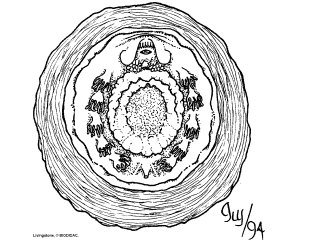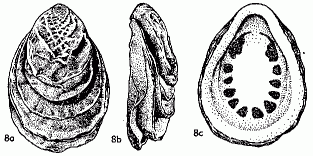
(Monoplacophora)
| Palaeos |  |
Tryblidiida |
| Mollusca | Tryblidiida (Monoplacophora) |
| Page Back | Unit Up | Clade Up: Conchifera | Page Next |
| Unit Back: Conchifera | Clade Down: None for crown group Tryblidiida | References | Unit Next |
|
Abbreviated Dendrogram
MOLLUSCA |==ACULIFERA `--CONCHIFERA |--+--TRYBLIDIIDA | `--CEPHALOPODA `--+--SCAPHOPODA |--BIVALVIA `--GASTROPODA |
Contents
Overview |
Taxa on This Page
Trying to establish a systemmatic classification of the "Monoplacophora" is not easy, especially since it seems that "Monoplacophora" is a polyphyletic grade rather than a natural group.
As with all molluscs, and understanding of the soft parts are important, and, apart from the living Neopilina, representing only a single order and family of this once diverse group, and muscle scars on fossil shells, these are lacking. In the now dated volume of the Treatise, Knight & Yochelson (1960) review all known forms, and have two or three orders and 5 or 6 families (some taxa have a question mark next to them). Runnegar Jell (1976) present a simpler arrangement, synonymising several higher taxa. This results in 3 orders (including Bellerophontids) and eight or nine familes, but this includes many taxa that Peel (1991) transfers to the Helcionelloida, and Wagner to the Helcionelloida and "Quasirostroconchs". In any case, if the early evolution of other groups is anything to go on, it is likely that the "Monoplacophora" were quite diverse as far as high-level taxa go, even if there were not many different types on the level of species
It is quite likely that the "Monoplacophora" is a polyphyletic grouping, as cladistic analysis gives confusing results. Waller 1998 shows that the Tryblidiida are the sister group of all other Conchifera. While Wagner, in a more complex cladogram based on an analysis of a large number of early Paleozoic gastropods and other molluscs (see illustration above), has the "Tergomya" (Kiringella, Hypseloconida, and Cyrtolites ) as the sister-group to Tropidodiscid Bellerophonts, and from those in turn the sister group of Gastropods proper. Which implies (Helcionelloida (Cyrtosoma (Kiringella + Hypseloconida (Cyrtolites (Tropidodiscidae (Gastropoda))))).
For this reason I would limit use of the term "Monoplacophora" sensu strictu to the Tryblidiida, which are a monophyletic off-shoot of the basal Conchifera, the Helcionelloida, which are a more derived but paraphyletic group of basal Conchifera, and the Tergomya minus the Tryblidiida, which are an early sister group to the proto-gastropods, also probably paraphyletic.
Eventually, as more studies and cladistic analysis is done on basal molluscs, a more complete picture should emerge.

The Tryblidiida include the typical "Monoplacophora" - a number of early Paleozoic forms, and are represented among today's biota by the "living fossil" Neopilina. It is possible that they represent an ancestral molluscan type. Runnegar & Pojeta (1974). Cladistic analysis (Waller, 1998) shows that they are the sister group of all other Conchifera.

The Tryblidiida first appear in the fossil record during the earliest Middle (Runnegar & Jell, 1976 ) or Late (Yochelson 1978) Cambrian (earlier forms are now considered to be Helcionelloidans), a time when mollusks were undergoing a great evolutionary radiation with a number of new classes appearing. It is possible that they evolved from earlier soft-bodied ancestors. Alternatively they are a late group and their primitive features misleading.
Although never a diverse or abundant group, they are well-represented in the fossil record from the Furongian to the Devonian. After that time they disappear; so it can be assumed that is when they migrated to the deep water environments they still occupy today.
Until the discovery of the deep-sea mollusk Neopilina in 1952, the Tryblidiida and other "Monoplacophora" were considered to be an extinct branch of early primitive untorted gastropods, called "Amphigastropods" [Moore et al, 1952]. Modern forms appear to be little changed from their early Paleozoic ancestors. It is likely that these Paleozoic forms were benthic algal/bacterial grazers in shallow marine environment of varying energy [ref http://www.ualr.edu/~ersc/Paleontology/Mollusca.html], and that the migration to deep sea benthos probably occurred later.
Seven or eight living species of Neopilina are known (with quite likely more awaiting discovery), and have usually been dredged from depths of between 2000 and 6500 meters in the South Atlantic, Gulf of Aden, and East Pacific. (Barnes, 1980). While a widespread part of the deep water benthos, their ecology is unknown. Modern forms appear to be little changed since the early Paleozoic.
Tryblidiids are modestly sized molluscs (Neopilina does not exceed 3 cm, and Paleozoic forms were mostly of similar size), with a simple exogastrically-curved limpet-like shell. They are distinguished by the fact that virtually all organ systems are found in multiples. Neopilina has 6 pairs of gills and of nephridia, 8 pairs of retractor muscles, 2 pairs of gonads and auricles, and so on. Barnes (1980); http://www.reefkeeping.com/issues/2002-08/rs/. While the soft parts of extinct forms are not known, the fact that fossil species show multiple muscle scars indicate a similar bauplan.
This pseudo-metameric or quasi-segmented body plan led to the idea that "Monoplacophora" had a common ancestry with other metameric coelomates like annelids and arthropods. However, neither extant aplacophoran primitive molluscs or Cambrian pre-annelid and pre-molluscan halwaxiids like Wiwaxia and Halkeria are obviously segmented (although the regular series of scales in the latter two forms may be the beginning of segmentation). It is possible then that the multiple organ systems and body segments developed independently among a number of different organisms.
Runnegar & Pojeta (1974) suggest that Polyplacophora with their segmented shells evolved from "Monoplacophora" ancestors, but it is also possible again that this adaptation developed independently, although Knight & Yochelson suggest a relationship between the Polyplacophora and Tryblidiida. However, Waller 1998 and other cladistic analysis does not indicate that the Polyplacophora and Tryblidiida are a natural group or clade within the Mollusca.
Tryblidiida Lemche, 1957
Synonyms: Monoplacophora Odhner, 1940 (para/polyphyletic as originally defined)
Range: Fr ECambrian
Phylogeny: Conchifera : (Scaphopoda + Bivalvia + Gastropoda) + (Cephalopoda + *)
Characters: relict, deep sea, limpet-like forms, bilaterally symmetrical, metameric (quasi-segmented). The body has a distinct head, but there are no eyes or sensory tentacles (except around the mouth). The foot is weakly muscular; anus median, posterior; mantle cavity large, extending laterally and posteriorly around the foot with 5-6 pairs of ctenidia; 8 pairs of pedal-retractor muscles; 6 metanephridia; sexes separate; fertilization external. - mostly from Jack R. Holt
Comments: Originally considered the ancestral molluscan type, then the sister taxon to all other conchiferan groups (gastropods, cephalopods, scaphopods, and bivalves), one recent molecular phylogeny makes them the sister taxon to cephalopoda alone. In any case, they would be close to the conchiferan ancestor. Well represented in the fossil record from the Cambrian to the Devonian and thought to be extinct, until living animals were found off the Pacific coast of Costa Rica in 1952 (cited in Ruppert et al. 2004). About 20 extant species are known, although many more are presumed to occur in the deep oceans. Jack R. Holt, MAK120612
Monoplacophora sensu lato. as defined in Runnegar & Jell (1976) would include three orders including the Tryblidiida. Problems arise from the ambiguous position of some paleozoic fossil taxa which could be monoplacophorans or gastropods, or (worse) stem-group gastropods derived from monoplacophorans, thus making Monoplacophora paraphyletic. Preference for the name Tryblidiida follows Waller's (1998) conclusion that these are the sister-group to all other Conchifera, thus escaping being paraphyletic. Giribet et al. (2006): claimed that the monoplacophoran Laevipilina is recovered within a branch containing polyplacophoran taxa in an analysis including several nuclear and mitochondrial sequences. As mentioned above, this result based on a very small specimen is ignored in the classification draft until further confirmed. - Gofas, S. (2012). Monoplacophora. (Accessed through: World Register of Marine Species at http://www.marinespecies.org/aphia.php?p=taxdetails&id=415 on 2012-06-07 Creative Commons Attribution)
Reference: Lemche H. (1957). A new living deep-sea mollusc of the Cambro-Devonian class Monoplacophora. Nature 179: 413-416 fig. 1-4
Links Monoplacophora - intro; Mollusca - Class Monoplacophora - short intro
| Page Back | Unit Home | Page Top | Page Next |
page uploaded 29 September 2002, last modified 28 December, page by M. Alan Kazlev (Creative Commons Attribution license)reformatted and moved ATW051013, checked ATW050731, last revised MAK120612 Creative Commons Attribution